|
|
 |
Fiche d'espèce de Copépode |
|
|
Calanoida ( Ordre ) |
|
|
|
Clausocalanoidea ( Superfamille ) |
|
|
|
Aetideidae ( Famille ) |
|
|
|
Aetideus ( Genre ) |
|
|
| |
Aetideus armatus (Boeck, 1872) (F,M) | |
| | | | | | | Syn.: | Pseudocalanus armatus Boeck, 1872; Brady, 1878 (p.46, figs.F);
Aetidius armatus : Brady, 1883 (part., p.76, figs.F); Sars, 1901 a (1903) (p.25, figs.F,M); T. Scott, 1902 (p.451, Rem.); Wolfenden, 1911 (p.209, figs.F); With, 1915 (p.75, figs.F); Hardy & Gunther, 1935 (1936) (p.157, Rem.); Maclellan D.C., 1967 (p.101, 102: occurrence); De Decker, 1968 (p.45); Falkenhaug & al., 1997 (p.449, spatio-temporal pattern); Hunt, 2004 (p.1, 43, Table 3.2); Papastephanou & al., 2006 (p.3078, Table 3);
Aethidius armatus: Cleve, 1904 a (p.185); A. tenuirostris Wolfenden, 1904 (p.116, Rem.);
Paraetideus armatus : Paulsen, 1909;
no A. armatus : Giesbrecht, 1892 (p.213); Giesbrecht & Schmeil, 1898 (p.31);
Undinopsis armatus : Shih & Young, 1995 (p.67);
no A. armatus : Esterly, 1905 (p.145, figs.F); Campbell, 1929 (p.311); ? Tanaka, 1957 a (p.31, figs.F,M); Aetideus armatus s.l. : Brinton & al., 1986 (p.228, Table 1); | | | | Ref.: | | | Thompson & Scott, 1903 (p.233, 244); Farran, 1908 b (p.28); A. Scott, 1909 (p.37, figs.F); Lysholm, 1913 (p.5); Pesta, 1920 (p.507); Lysholm & Nordgaard, 1921 (p.11); Sars, 1925 (p.41); Farran, 1926 (p.246); 1929 (p.208, 228); Sewell, 1929 (p.99); Sciacchitano, 1930 (p.12, Rem.); Wilson, 1932 a (p.45, figs.F,M); Rose, 1933 a (p.80, figs.F,M); Jespersen, 1934 (p.52); Farran, 1936 a (p.87); Jespersen, 1940 (p.17); Mori, 1937 (1964) (p.38, figs. juv.F,M); Davis, 1949 (p.25, figs.F); Brodsky, 1950 (1967) (p.144, figs.F,M); Vervoort, 1952 a (n°42, p.3, figs.F,M); 1957 (p.44, Rem.); Vervoort, 1963 b (p.122, Rem.); Gaudy, 1963 (p.22); Matthews, 1964 (p.24, Rem.); Chen & Zhang, 1965 (p.50, figs.F); Owre & Foyo, 1967 (p.43, figs.F,M); Mazza, 1967 (p.108, 138, figs.juv., F,M, Rem.); 1968 (p.531, figs.); Park, 1968 (p.544, Rem.); Ramirez, 1969 (p.57, figs.F,M, Rem.); Vaupel-Klein, 1970 (p.4, 10, Rem.); Bradford, 1971 (p.15, figs.F, Rem); 1972 (p.36, figs.F,M); Razouls, 1972 (p.94, Annexe: p.39, figs.F,M); Park, 1974 (p.215, Rem.); Arcos, 1975 (p.15, figs.F,M); Park, 1978 (p.104); Dawson & Knatz, 1980 (p.6, figs.F,M); Björnberg & al., 1981 (p.604, 630, figs.F,M); Zheng Zhong & al., 1984 (1989) (p.235, figs.F); Razouls, 1994 (p.62, figs.F,M); Markhaseva, 1996 (p.14, figs.F,M, Rem.); Chihara & Murano, 1997 (p.682, Pl.32: F); Bradford-Grieve & al., 1999 (p.879, 920, figs.F,M); G. Harding, 2004 (p.53, 54, figs.F ,M); Vives & Shmeleva, 2007 (p.544, figs.F,M, Rem.); Blanco-Bercial & al., 2011 (p.103, Table 1, Biol. mol, phylogeny) | 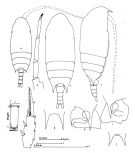 issued from : J.M. Bradford in N.Z. Jl Mar. Freshw. Res., 1971, 5 (1). [p.17, Fig.3]. From SW Africa (21°-35°S). Male : a, habitus (dorsal); b, P5; c, caudal ramus; d, 3rd exopod segment of P3. Nota: Posterior thoracic points extend up to (but not past), the posterior border of urosomal segment 1. Width: length ratio of caudal rami is 1: 2.58-2.70. Terminal seta on P2-P4 with 24, 22 and 18 teeth respectively. Female: e, habitus (dorsal); f, idem (lateral right side); g, rostrum; h, genital segment and posterior thoracic points (lateral left side); i, idem (lateral right side); j, rostrum. Nota: Posterior thoracic points just passed the posterior border of the genital segment, seminal receptacles with a thick, short tube joining the dorsal and ventral sacs. Rostrum: width/depth about 0.86-1.3 (falling within the range of the 2 specimens from Norway). Anterior cephalothorax vaulted, heavily chitinized and when viewed laterally indented above the base of A1 (characteristic not noted in the Norwegian specimens).
|
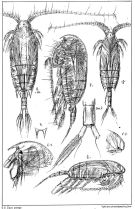 issued from : Sars G.O. in An Account of the Crustacea of Norway. Vol. IV. Copepoda Calanoida. Published by the Bergen Museum, 1903. [Pl. XIII]. As Aetidius armatus. Female & Male. C = forehead (lateral); R = rostrum (frontal view);
|
 issued from : Sars G.O. in An Account of the Crustacea of Norway. Vol. IV. Copepoda Calanoida. Published by the Bergen Museum, 1903. [Pl. XIV]. As Aetidius armatus. Female & Male. M = Md; m = Mx1; mp1 = Mx2; mp2 = Mxp.
|
 issued from : J.M. Bradford in N.Z. Jl Mar. Freshw. Res., 1971, 5 (1). [p.15, Fig.2]. Female (drawn from mounted specimens from Sars' collection): a, A2; b, Md (cutting edge); c, Md (mandibular palp); d, Mx1; e, Mx2; f, Mxp; g, P1; h, P2; i, P4. Nota: Anterior integument covered with very small chitinous thickenings (visible only under phase contrast). Terminal spines of P2-P4 with 16, 17, 15 teeth respectively (although the numbers vary slightly between specimens). Seminal receptacle similar to A. australis
|
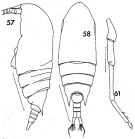 issued from : F.C. Ramirez in Contr. Inst. Biol. mar., Buenos Aires, 1969, 98. [p.56, Lam. IX, figs.57, 58, 61]. Female (from off Mar del Plata): 57, habitus (lateral left side); 58, idem (dorsal). Male: 61, P5. Scale bars in mm: 0.6 (57, 58); 0.1 (61).
|
 issued from : A. Scott in Siboga-Expedition, 1909, XIX a. [Plate IV, Figs.14-25]. Female (from Indonesia-Malaysia): 14, habitus (dorsal); 15, forehead (lateral); 16, last thoracic and genital segments (left side); 17, rostrum; 18, A1; 19, A2; 20, Md; 21, Mx2; 22, Mxp; 23, P1; 24, P2; 25, P3.
|
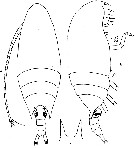 issued from : R.N. Wolfenden in Die Marinen Copepoden der Deutschen Südpolar-Expedition 1901-1903, 1911. [p.208, Fig.4]. As Aetidius armatus. Female: a-b, habitus (dorsal and lateral, respectively); c, rostrum
|
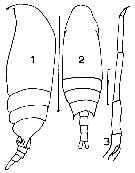 issued from : J.M. Bradford in Mem. N. Z. Oceonogr. Inst., 1972, 54. [p.37, Fig.6 (1-3)]. Female (from Kaikoura, New Zealand): 1, habitus (lateral). Male: 2, habitus (dorsal); 3, P5. Scale bars: 1 mm (1, 2); 0.1 mm (3).
|
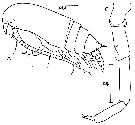 issued from : C. Razouls in Th. Doc. Etat Fac. Sc. Paris VI, 1972, Annexe. [Fig.41, A, C]. Female: A, habitus (lateral). Male: C, P5.
|
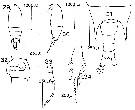 issued from : D.F.R. Arcos in Gayana, Zool., 1975, 32. [Lam.IV, Figs.29-34]. Female (from Bahia de Concepcion, Chile): 29-30, habitus (dorsal and lateral, respectively); 31, last thoracic segment and urosome (dorsal); 32, genital segment (lateral, left side); 34, exopodite segment 3 of P4. male: 33, P5.
|
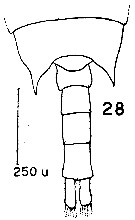 issued from : D.F.R. Arcos in Gayana, Zool., 1975, 32. [Lam.III, Fig.28]. Male: 28, last thoracic segment and urosome (dorsal).
|
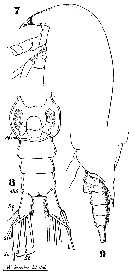 Issued from : W. Giesbrecht in Systematik und Faunistik der Pelagischen Copepoden des Golfes von Neapel und der angrenzenden Meeres-Abschnitte. – Fauna Flora Golf. Neapel, 1892. Atlas von 54 Tafeln. [Taf. 36 , Figs.7, 8, 9]. As Aëtidius armatus. Female: 7, forehead (lateral); 8, urosome (ventral); 9, last thoracic segment and urosome (lateral, left side).
|
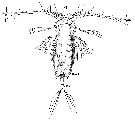 Issued from : W. Giesbrecht in Systematik und Faunistik der Pelagischen Copepoden des Golfes von Neapel und der angrenzenden Meeres-Abschnitte. – Fauna Flora Golf. Neapel, 1892. Atlas von 54 Tafeln. [Taf. 36 , Fig.6]. As Aëtidius armatus. Male: 6, habitus (dorsal).
|
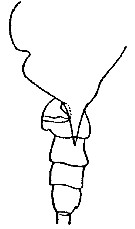 issued from : C. With in The Danish Ingolf-Expedition, 1915, III (4). [p.75, Text-Fig.16]. As Aetidius armatus. Female (from 61°-67°N, 9°-55°W):distal part of prosome and urosome (lateral, left side).
|
 issued from : C. With in The Danish Ingolf-Expedition, 1915, III (4). [Pl. II, Figs.1a, 1b]. As Aetidius armatus. Female: 1a, genital segment (left side); 1b, same (ventral).
|
 issued from : C. With in The Danish Ingolf-Expedition, 1915, III (4). [Pl. II, Figs.1c, 1d]. As Aetidius armatus. Female: 1c, basipod of left P4 (posterior); 1d, lamina labialis. Nota: The basipod 2 of P4 has, in addition to marginal row of setae, posteriorly and just proximally to the inner seta a transverse row of 4 short spines (1c), which corresponds to the two spines mentioned by Giesbrecht but not by Sars and Scott. Glandular pores were found at the base of outer seta of exopod 2 and outer seta of exopod 3 in the three posterior pair of legs, and in addition to these a pore was found at the base of outer seta of exopod 1 in P3-P4. The lamina labialis and the setae in front of it have a structure as shown in fig. 1d.
|
 issued from : G. Harding in Key to the adullt pelagic calanoid copepods found over the continental shelf of the Canadian Atlantic coast. Bedford Inst. Oceanogr., Dartmouth, Nova Scotia, 2004. [p.53]. Female. P1: Exopodite 1 without spine on the outer margin (arrowed). P2: Endopodal segments 1 and 2 incompletely separated (arrowed).
|
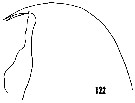 issued from : H.B. Owre & M. Foyo in Fauna Caribaea, 1, Crustacea, 1: Copepoda. Copepods of the Florida Current. [p.26, Fig.122]. Female: 122, forehead (lateral).
|
 issued from : J.M. Bradford in N.Z. Jl Mar. Freshw. Res., 1971, 5 (1). [p.18, Fig.4, a]. [modified C.R] Rostrum width : depth plotted against rostrum depth (c) for Aetideus armatus. SA: Southern African specimens. Compare with A. australis, A. truncatus, A. divergens and A. pseudarmatus.
|
 issued from : E.L. Markhaseva in Trudy Zool. Inst. RAN, St. Petersburg, 1996, 268. [p.16, Fig.4]. Female (from 48°33'N, 18°52'W).
|
 Aetideus armatus Aetideus armatus female: 1 - Posterior corners of last thoracic segment prolonged into points. 2 - Posterior corners of last thoracic segment not prolonged into wing-like lobes. Points not reaching the middle of urosomal segment 2. Anterior part of cephalon without crest. 3 - Basipodite of right P1 without external tooth-like projection distally. Coxopodite of P4 usually with spinules near the base of internal seta. 4 - Points of posterior corners reaching or exceeding posterior border of genital segment. 5 - Spermatheca with short duct connecting its dorsal and ventral parts.
|
 Aetideus armatus Aetideus armatus male: 1 - Last thoracic segment with points. 2 - Points not exceeding posterior border of urosomal segment 1 (in dorsal view). 3 - 2nd segment of P5 2.3-3.1 times as long as wide. 4 - Exopodite 3 of P3 with terminal spine shorter than the segment itself.
|
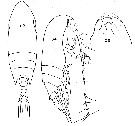 Issued from : C. Séret in Thesis UPMC, Paris 6. 1979 [Pl. XI, figs.63-65]. Female (from off N Kerguelen Is.): 63-64, habitus (dorsal and lateral, respectively); 65, forehead showing rostrum (ventral view).
|
 Issued from : C. Razouls in Ann. Inst. océanogr., Paris, 1994, 70 (1). [p.2562]. Caractéristiques morphologiques de Aetideus armatus femelle et mâle adultes. Terminologie et abbréviations: voir à Calanus propinquus. Nota: Bradford (1971, p.12 & suiv.) montre qu'il existe des différences parmi les formes identifiées comme A. armatus par divers auteurs. Chez la femelle, les critères de différenciation des espèces portent sur le rostre, la longueur des pointes thoraciques postérieures, des A1, et la spermathèque; Chez le mâle, le rostre, la longueur des pointes thoraciques postérieures, les proportions des rames caudales et des segments 2, 3, 4 de la P5.
|
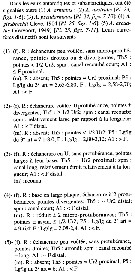 Issued from : C. Razouls in Ann. Inst. océanogr., Paris, 1994, 70 (1). [p.62]. Caractéristiques morphologiques comparées entre A. armatus, A. australis, A. pseudarmatus, A. giesbrechti, A. arcuatus, femelle et mâle adultes. Terminologie et abbréviations: voir à Calanus propinquus.
| | | | | Ref. compl.: | | | Pearson, 1906 (p.11, Rem.); Rose, 1925 (p.152); Wilson, 1942 a (p.170); Lysholm & al., 1945 (p.11); Sewell, 1948 (p.347, 499, 508, 512, 516, 525, 545, 549, 555, 559, 566); C.B. Wilson, 1950 (p.159); Gundersen, 1953 (p.1, 26, seasonal abundance); Østvedt, 1955 Table 3, p.59); Minoda, 1958 (p.253, Table 1, abundance); Yamazi, 1958 (p.148, Rem.); Fagetti, 1962 (p.17); Cervigon, 1962 (p.181, tables: abundance distribution); Grice & Hart, 1962 (p.287, table 3); Gaudy, 1962 (p.93, 99, Rem.: p.105); Duran, 1963 (p.15); V.N. Greze, 1963 a (tabl.2); Shmeleva, 1963 (p.141); Grice, 1963 a (p.495); Gaudy, 1963 (p.22, Rem.); Unterüberbacher, 1964 (p.21, Rem.M); De Decker & Mombeck, 1964 (p.11); Shmeleva, 1965 b (p.1350, lengths-volume -weight relation); Grice & Hulsemann, 1965 (p.223); Furuhashi, 1966 a (p.295, vertical distribution in Kuroshio region, Table 9); Mazza, 1966 (p.70); Pavlova, 1966 (p.43); Matthews, 1967 (p.159, Table 1, Rem.); Fleminger, 1967 a (tabl.1); Grice & Hulsemann, 1967 (p.14); Berdugo & Kimor, 1968 (p.448); Dowidar & El-Maghraby, 1970 (p.267); Park, 1970 (p.475); Shih & al., 1971 (p.31, 142); Deevey, 1971 (p.224); Gamulin, 1971 (p.382, tab.3); Carli, 1971 (p.373, tab.2); Apostolopoulou, 1972 (p.327, 345); Boucher & Thiriot, 1972 (p.47, Tableau 4); Roe, 1972 (p.277, tabl.1, tabl.2); 1972 a (p.332); Bainbridge, 1972 (p.61, Appendix Table I: vertical distribution vs day/night); Björnberg, 1973 (p.326, 384); Vives & al., 1975 (p.41, tab.II, III, IV); Vives, 1976 (p.104); Deevey & Brooks, 1977 (p.256, tab.2, Station "S"); Carter, 1977 (1978) (p.35); Arashkevich, 1978 (p.118, Table: diets); Dessier, 1979 (p.204); Vaissière & Séguin, 1980 (p.23, tab.1); Pipe & Coombs, 1980 (p.223, figs. 1, 2, table 1, vertical distribution); Vives, 1982 (p.290); Kovalev & Schmeleva, 1982 (p.83); Huntley & al., 1983 (p.143, Table 2); Brenning, 1983 (p.1, spatial distribution, T-S diagram, Rem.); Tremblay & Anderson, 1984 (p.3); De Decker, 1984 (p.316); Guangshan & Honglin, 1984 (p.118, tab.); Roe, 1984 (p.356); Scotto di Carlo & al., 1984 (p.1044); Tremblay & Anderson, 1984 (p.3); Sameoto, 1984 (p.767, vertical migration); Brenning, 1985 a (p.28, Table 2); Regner, 1985 (p.11, Rem.: p.30, as Aetidus ); Madhupratap & Haridas, 1986 (p.105, tab.1); Lozano Soldevilla & al., 1988 (p.58); Jimenez-Perez & Lara-Lara, 1988; Hernandez-Trujillo, 1989 a (tab.1); Cervantes-Duarte & Hernandez-Trujillo, 1989 (tab.3); Fransz & al., 1991 (p.9); Yoo, 1991 (tab.1); Hernandez-Trujillo, 1991 (1993) (tab.I); Hattori, 1991 (tab.1, Appendix); Hays & al., 1994 (tab.1); Kouwenberg, 1994 (tab.1); Hajderi, 1995 (p.542); Shih & Young, 1995 (p.66); Errhif & al., 1997 (p.422); Park & Choi, 1997 (Appendix); Suarez-Morales & Gasca, 1998 a (p107); Hure & Krsinic, 1998 (p.100); Padmavati & al., 1998 (p.349); Siokou-Frangou, 1999 (p.476); Halvorsen & Tande, 1999 (p.279, tab.2, 3, Rem.: p.282); Fernandez-Alamo & al., 2000 (p.1139, Appendix); Lapernat, 2000 (tabl. 3, 4); Razouls & al., 2000 (p.343, Appendix); Seridji & Hafferssas, 2000 (tab.1); Lopez-Salgado & al., 2000 (tab.1); Moraitou-Apostolopoulou & al., 2000 (tab.I); d'Elbée, 2001(tabl. 1); Holmes, 2001 (p.45); Hunt & al., 2001 (p.374, tab.1); Beaugrand & al., 2002 (p.1692); Beaugrand & al., 2002 (p.179, figs.5, 6); Sameoto & al., 2002 (p.12); Vukanic, 2003 (139, tab.1); CPR, 2004 (p.49, fig.134); Berasategui & al., 2005 (p.313, fig.2); Hop & al., 2006 (p.182, Table 4); Isari & al., 2006 (p.241, tab.II); Kosobokova & al., 2007 (p.929: Tab.7); Valdés & al., 2007 (p.103: tab.1); Khelifi-Touhami & al., 2007 (p.327, Table 1); Castro & al., 2007 (p.486, fig.3, 5, Table 1, 2, 3); Cabal & al., 2008 (289, Table 1); Morales-Ramirez & Suarez-Morales, 2008 (p.517); Fernandes, 2008 (p.465, Tabl.2); Wishner & al., 2008 (p.163, Table 2, fig.8, oxycline); Ayon & al., 2008 (p.238, Table 4: Peruvian samples); Gaard & al., 2008 (p.59, Table 1, N Mid-Atlantic Ridge); Raybaud & al., 2008 (p.1765, Table A1); Galbraith, 2009 (pers. comm.); Licandro & Icardi, 2009 (p.17, Table 4); C.E. Morales & al., 2010 (p.158, Table 1); Schnack-Schiel & al., 2010 (p.2064, Table 2: E Atlantic subtropical/tropical); Hidalgo & al., 2010 (p.2089, Table 2); Mazzocchi & Di Capua, 2010 (p.423); Medellin-Mora & Navas S., 2010 (p.265, Tab. 2); Mazzocchi & al., 2011 (p.1163, fig.6, long-term time-series 1984-2006); Andersen N.G. & al., 2011 (p.71, Fig.3: abundance); Isari & al., 2011 (p.51, Table 2, abundance vs distribution); Selifonova, 2011 a (p.77, Table 1, alien species in Black Sea); Shiganova & al., 2012 (p.61, Table 4): Salah S. & al., 2012 (p.155, Tableau 1); Zizah & al., 2012 (p.79, Tableau I); Miloslavic & al., 2012 (p.165, Table 2, transect distribution); Brugnano & al., 2012 (p.207, Table 2); Mazzocchi & al., 2012 (p.135, annual abundance 1984-2006); Alvarez-Fernandez & al., 2012 (p.21, Rem.: Table 1); Hidalgo & al., 2012 (p.134, Table 2, 3, figs.6, 8, occurrence vs hydrology); Belmonte & al., 2013 (p.222, Table 2, abundance vs stations); Palomares-Garcia & al., 2013 (p.1009, Table I, V, abundance vs environmental factors); in CalCOFI regional list (MDO, Nov. 2013; M. Ohman, pers. comm.); Sobrinho-Gonçalves & al., 2013 (p.713, Table 2, fig.8, seasonal abundance vs environmental conditions); Bode M. & al., 2013 (p.1, Table 1, respiration rate & ETS activity); Fierro Gonzalvez, 2014 (p.1, Tab. 3, 5, occurrence, abundance); Zaafa & al., 2014 (p.67, Table I, occurrence): Zakaria & al., 2016 (p.1, Table 1, Rem.); Benedetti & al., 2016 (p.159, Table I, fig.1, functional characters); Jerez-Guerrero & al., 2017 (p.1046, Table 1: temporal occurrence); El Arraj & al., 2017 (p.272, table 2); Benedetti & al., 2018 (p.1, Fig.2: ecological functional group); Belmonte, 2018 (p.273, Table I: Italian zones); Chaouadi & Hafferssas, 2018 (p.913, Table II: occurrence); Palomares-Garcia & al., 2018 (p.178, Table 1: occurrence no seen in La Paz); Acha & al., 2020 (p.1, Table 3: occurrence % vs ecoregions, Table 5: indicator ecoregions). | | | | NZ: | 24 | | |
|
Carte de distribution de Aetideus armatus par zones géographiques
|
| | | | | | | | | | | | | | | | | |  issued from : A.A. Shmeleva in Bull. Inst. Oceanogr., Monaco, 1965, 65 (n°1351). [Table 6: 17 ]. Aetideus armatus (from South Adriatic). issued from : A.A. Shmeleva in Bull. Inst. Oceanogr., Monaco, 1965, 65 (n°1351). [Table 6: 17 ]. Aetideus armatus (from South Adriatic).
Dimensions, volume and Weight wet. Means for 50-60 specimens. Volume and weight calculated by geometrical method. Assumed that the specific gravity of the Copepod body is equal to 1, then the volume will correspond to the weight. |
 issued from : U. Brenning in Wiss. Z. Wilhelm-Pieck-Univ. Rostock - 32. Jahrgang 1983. Mat.-nat. wiss. Reihe, 5. [p.1, Figs.1, 2]. issued from : U. Brenning in Wiss. Z. Wilhelm-Pieck-Univ. Rostock - 32. Jahrgang 1983. Mat.-nat. wiss. Reihe, 5. [p.1, Figs.1, 2].
Spatial distribution and T-S Diagram for Aetideus armatus, Aetideus giesbrechti and Aetideopsis carinata from 8° S - 26° N; 16°- 20° W. |
 Issued from : C. Séret in Thesis 3ème Cycle, UPMC, Paris 6. 1979, Annexe. [p.29]. Issued from : C. Séret in Thesis 3ème Cycle, UPMC, Paris 6. 1979, Annexe. [p.29].
Geographical occurrences of Aetideus armatus in the Indian Ocean and Antarctic zone. [after publications from: Brady, 1883, 1918; Thompson, 1900; Wolfenden, 1908, 1911; With , 1915; Rosendorn, 1917; Farran, 1929; Sewell, 1929, 1947; Brady & Gunther, 1935; Steuer, 1929, 1392, 1933; Ommaney, 1936; Vervoort, 1957; Tanaka, 1960; Brodsky, 1964; Seno, 1966; Andrews, 1966; Grice & Hulsemann, 1967; Seno, 1966; Frost & Fleminger, 1968; Voronina, 1970; Zverva, 1972].
C. Séret notes the occurrence at station 46°S, 64°E. |
 Issued from : M. Bode, A. Schukat, W. Hagen & H. Auel in J. Exp. Mar. Biol. Ecol., 2013, 444. [p.3, Table 1]. Issued from : M. Bode, A. Schukat, W. Hagen & H. Auel in J. Exp. Mar. Biol. Ecol., 2013, 444. [p.3, Table 1].
Dry mass, individual respiration rate and ETS activity from the northern Benguela Current upwelling system along transects at 23°S and 26°40'S, off Walvisbay and Lüderitz (Namibia).
Relationship between individual ETS activities and individual respiration rates; mean ETS activities with standard deviations are plotted again mean respiration rates (Cf. in Calanoides natalis. The letter besides each point identifies the associated species in Table 1 (b) for this species) in the same authors.
Cf. Table 1: Dry mass, individual respiration rate and ETS activity. |
| | | | Loc: | | | Cosmopolite: tropical & temperate (except Arct.), Also Antarct. (Atlant. SW, South Georgia, Indian), sub-Antarct. (Atlant. SW, off W Prince Edward, Indian, Kerguelen Is., Pacif. SW, SE), G. of St. Lawrence, off SE Nova Scotia, Davis Strait, Ameralik & Godthaab fjords, Wyville Thomson Ridge, Kongsfjorden (E Spitzbergen), Iceland, off Faroe, Norwegian Sea, Malangen fjord, Raunefjorden, North Sea, English Channel, Mediterannean Sea, W Egyptian coast, Marmara Sea, Black Sea, Arabian Sea, China Seas (Yellow Sea, East China Sea, South China Sea), Japan, Chile (N-S, off Santiago), CalCOFI region, G. of California, Caribbean Colombia (San Andrés y Providencia), Station "S" (32°10'N, 64°30'W), Peru | | | | N: | 239 | | | | Lg.: | | | (7) F: 1,93; (14) F: 1,7-1,65; (22) F: 1,95-1,80; M: 1,53-1,4; (34) F: 1,44-1,33; (35) F: 1,84-1,68; (37) F: 2-1,6; M: 1,53-1,3; (38) F: 1,95-1,8; M: 1,53; ? (39) F: 1,82; M: 1,8; (45) F: 1,8; M: 1,45-1,25; (59) F: 2-1,8; M: 1,5-1,4; (65) F: 1,8; M: 1,45; (72) F: 2,02-1,8; (116) F: 1,78; M: 1,56; (199) F: 1,9-1,6; (202) F: 1,78-1,95; M: 1,4-1,56; (204) F: 1,9-1,6; M: 1,5-1,3; (205) F: 2,25-2,15; M: 2,1-2; (244) F: 1,9; (246) F: 1,91-2,12; (290) F: 1,6-1,75; (432) F: 1,98-1,83; (449) F: 1,8; M: 1,45; (866) F: 1,65-1,95; M: 1,4-1,8; (920) F: 1,51; (1109) F: 1,58-1,87; {F: 1,33-2,25; M: 1,25-2,10}
The mean female size is 1.811 mm (n = 42; SD = 0.1884), and the mean male size is 1.534 mm (n = 21; SD = 0.2198). The size ratio (male : female) is approximately 0.83 (n = 13; SD = 0.0707). | | | | Rem.: | épi-bathypélagique.
Sampling depth (Antarct., sub-Antarct.) : 0-600; 100-1000 m.
Voir aussi les remarques en anglais | | | Dernière mise à jour : 25/10/2022 | |
|
|
 Toute utilisation de ce site pour une publication sera mentionnée avec la référence suivante : Toute utilisation de ce site pour une publication sera mentionnée avec la référence suivante :
Razouls C., Desreumaux N., Kouwenberg J. et de Bovée F., 2005-2025. - Biodiversité des Copépodes planctoniques marins (morphologie, répartition géographique et données biologiques). Sorbonne Université, CNRS. Disponible sur http://copepodes.obs-banyuls.fr [Accédé le 29 novembre 2025] © copyright 2005-2025 Sorbonne Université, CNRS
|
|
 |
 |



























